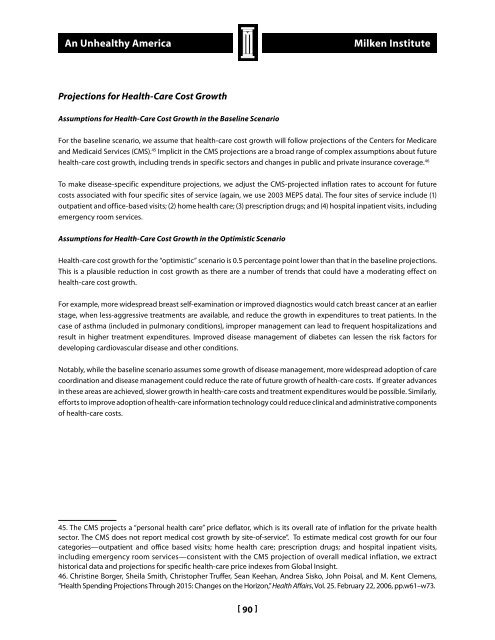An Unhealthy America: The Economic Burden of ... - Milken Institute
An Unhealthy America: The Economic Burden of ... - Milken Institute
An Unhealthy America: The Economic Burden of ... - Milken Institute
You also want an ePaper? Increase the reach of your titles
YUMPU automatically turns print PDFs into web optimized ePapers that Google loves.
<strong>An</strong> <strong>Unhealthy</strong> <strong>America</strong><strong>Milken</strong> <strong>Institute</strong>Projections for Health-Care Cost GrowthAssumptions for Health-Care Cost Growth in the Baseline ScenarioFor the baseline scenario, we assume that health-care cost growth will follow projections <strong>of</strong> the Centers for Medicareand Medicaid Services (CMS). 45 Implicit in the CMS projections are a broad range <strong>of</strong> complex assumptions about futurehealth-care cost growth, including trends in specific sectors and changes in public and private insurance coverage. 46To make disease-specific expenditure projections, we adjust the CMS-projected inflation rates to account for futurecosts associated with four specific sites <strong>of</strong> service (again, we use 2003 MEPS data). <strong>The</strong> four sites <strong>of</strong> service include (1)outpatient and <strong>of</strong>fice-based visits; (2) home health care; (3) prescription drugs; and (4) hospital inpatient visits, includingemergency room services.Assumptions for Health-Care Cost Growth in the Optimistic ScenarioHealth-care cost growth for the “optimistic” scenario is 0.5 percentage point lower than that in the baseline projections.This is a plausible reduction in cost growth as there are a number <strong>of</strong> trends that could have a moderating effect onhealth-care cost growth.For example, more widespread breast self-examination or improved diagnostics would catch breast cancer at an earlierstage, when less-aggressive treatments are available, and reduce the growth in expenditures to treat patients. In thecase <strong>of</strong> asthma (included in pulmonary conditions), improper management can lead to frequent hospitalizations andresult in higher treatment expenditures. Improved disease management <strong>of</strong> diabetes can lessen the risk factors fordeveloping cardiovascular disease and other conditions.Notably, while the baseline scenario assumes some growth <strong>of</strong> disease management, more widespread adoption <strong>of</strong> carecoordination and disease management could reduce the rate <strong>of</strong> future growth <strong>of</strong> health-care costs. If greater advancesin these areas are achieved, slower growth in health-care costs and treatment expenditures would be possible. Similarly,efforts to improve adoption <strong>of</strong> health-care information technology could reduce clinical and administrative components<strong>of</strong> health-care costs.45. <strong>The</strong> CMS projects a “personal health care” price deflator, which is its overall rate <strong>of</strong> inflation for the private healthsector. <strong>The</strong> CMS does not report medical cost growth by site-<strong>of</strong>-service”. To estimate medical cost growth for our fourcategories—outpatient and <strong>of</strong>fice based visits; home health care; prescription drugs; and hospital inpatient visits,including emergency room services—consistent with the CMS projection <strong>of</strong> overall medical inflation, we extracthistorical data and projections for specific health-care price indexes from Global Insight.46. Christine Borger, Sheila Smith, Christopher Truffer, Sean Keehan, <strong>An</strong>drea Sisko, John Poisal, and M. Kent Clemens,“Health Spending Projections Through 2015: Changes on the Horizon,” Health Affairs, Vol. 25. February 22, 2006, pp.w61–w73.[ 90 ]
















